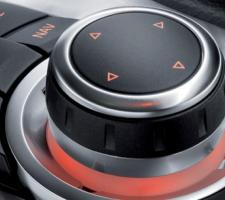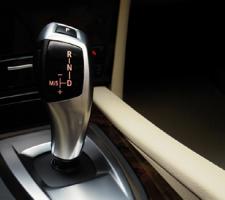
BMW's i-Drive system received a 'current best-in-class' rating from a series of experts who were asked to offer opinions on what the future user interface should look like
Dave McNamara and Craig Simonds,
The advanced UI is strategic to getting more features/functions into the car. A recent study by Telematics Update Business Intelligence identifies a $1.8 billion market in 2013 for displays, controls, software and so on. The overall Human-Machine Interface (HMI) revenue, with a CAGR of about 14 per cent (2009-2016), is significant. New hardware components will be added to allow drivers and passengers to access new features, especially connected vehicle services. HMI components are about 2-3 per cent of total Advanced Driver Assistance System (ADAS) and infotainment costs, which are growing at about 7-8 per cent annually: growth, not de-contenting of vehicles, can be expected. The HMI is the all-important means of bringing new content into the vehicle. Hence, it is strategic and worthy of investment as new, affordable, robust technology emerges.
Safety systems are the fastest-growing auto electronics segment, with Adaptive Cruise Control (ACC) and side vision in the vanguard. In the past, ABS, seat belts and airbags were the leaders. Today, OEMs are positioning ADAS, especially on luxury vehicles, as a key product differentiator. New safety features based on Vehicle-to-Vehicle (V2V) and Vehicle-to-Infrastructure (V2I or I2V) will emerge in the 2014-17 timeframe and have a significant impact on the automotive UI. The ultimate goal is autonomous or cooperative driving.
This article's basis is a comprehensive report for Telematics Update Business Intelligence, The Automotive User Interface, the Key Brand Differentiator. In-depth interviews with more than 30 experts in the US and Europe were conducted and 75 users and decision-makers were surveyed. They agreed on the strategic importance of the HMI and that their customers wanted both new safety and connectivity features. OEMs are learning from Apple and the Consumer Electronics (CE) industry and developing user experience-focused rather than task-centric UIs. Great user experiences are clearly defined by the iPhone and iPod, for example. Apple has showed that there is a market for the better user interface but what translates well from the CE world to the automotive word is still the subject of debate. Defining the user experience for the car means including a wide range of features and functions, encompassing safety, infotainment and now the use of devices outside the vehicle (remote control apps, for example).
Experts say the advanced UI is important as: a brand differentiator (overall the car is easier to use and safer than the competition's); an enabler of valued safety features/functions; new features mean current UIs have become a constraint, slowing time to market; a response to consumer demand (affordable, capable UIs are moving downscale because consumers want them); and a response to the CE industry (the CE industry drives demand but doesn't design with driving in mind and can't do integration at the vehicle level - OEMs need to take control and build a capable UI platform, therefore).
HMI development: a key enabler
OEMs think they are best at designing the UI with driving as the primary task but the OEM HMI development process is resource- and time-hungry. The process is geared to minimising the risk of inappropriate customer 'field testing' and distraction. But everyone agrees that safety features and connectivity sell cars. How do we get all these features/functions into the car while maintaining quality, reliability and affordability? In our survey of OEMs and suppliers, which asked what constitutes a 'best-in-class' HMI, 74.0 per cent of respondents gave ease of use as their main criterion. Some 12.3 per cent listed the ability to be used safely, 5.5 per cent listed aesthetics and attractiveness, and 2.7 per cent listed cost value.The industry as a first step has participated in government and industry cooperative efforts as a means to understand key safety-related problems. The Collision Avoidance Metrics Partnership (CAMP) is the key industry effort, in collaboration with NHTSA and the USDOT. CAMP, created by
The concern over ease of use applies to safety and connectivity features/functions alike. The key question is how well the features that interact directly with the driver through the senses and rely on him or her to take action work: do they have 'value', in the sense of reducing accidents without negative consequences? Relative to HMI development we ask a different set of questions about the effectiveness of the in-vehicle alerts.
Distraction is the key issue. The use of vehicle simulators has significantly increased the understanding of alerts and warnings. Ford,
To make these warning systems truly useful they must have a high degree of accuracy and not generate false positives. If drivers lose confidence in warning systems they will disregard them, so the accuracy and dependability of the detection system is as important as the effectiveness of the warning itself.
The OEMs surveyed all have formal design processes that are an intimate part of their overall vehicle design process. This implies that design guidelines must be met and verified before proceeding. Several Tier Ones also have a formal process around capturing customer and technology trends and verifying requirements. Some have indicated that they are currently creating a disciplined HMI process.
It is important to identify the Tier Two suppliers who are focused on providing platforms and tool sets for developing advanced UIs. The three most often mentioned in our interviews were Altia, Elektrobit, and MECEL, who are revolutionising UI design, providing software tools and collaborative approaches.
Advanced UIs - the future
We asked the experts who the current leaders are, what technologies and processes they employ and what the future UI will look like (with 2015 in view). Here are selected findings: The Audi A8's multi-modal UI received high marks (multi-modal means the use of large displays and easy-to-reach controls/steering wheel controls supplemented by voice).The use of large-panel displays in the cluster and centre stack featured strongly. Haptics will largely be a luxury vehicle application, as will be Organic LEDs (OLEDs). It's all about getting larger, more capable displays in the cars but affordability relative to application is the issue. Volume application, expected around 2015, is needed in HUDs and large-cluster LCDs before wider adoption in mid-range and smaller cars. The 2010 Range Rover with 12in LCD and the Lexus with super-bright OLEDs are showing us the future.
Haptics, as represented by the new
The resurgence of HUDs is expected as they become affordable and, more importantly, packageable. Significant growth in HUD applications is anticipated in the 2013-2015 timeframe.
2015 will be an important year for the auto industry and the UI. The US auto industry is expected to have restructured and largely recovered by then, returning to the 1976-2020 trend line of about 16 million vehicles sold per year. The vehicles of 2015 will be safe, connected and built on open, green, energy-efficient platforms. We think the new technological trends include: significant penetration of ADAS features augmented by IntelliDrive, with cooperative driving systems introduced; connected car technologies on all vehicle types, including mid-range and lower-end vehicles, with UIs designed to be safe, affordable, easy to use and aligned with brand identity; and adoption of best-practice HMI development processes and associated toolsets.
The strongest brands and suppliers will be the winners. They are best placed to respond to customer demands and have already adopted advanced UIs.
Adoption of the advanced UI will be steady and will require significant value engineering to achieve the right performance with quality and affordability. We expect governments to encourage and accelerate deployment through regulatory actions. For example in the US we expect NHTSA to use the New Car Assessment Program (NCAP) to encourage the construction and purchase of safer vehicles. It is important to the development of new active safety products that NHTSA has added new rating categories to NCAP. The current focus on crashworthiness testing will shift to crash-avoidance testing.
The HMI is indeed strategic as we go forward, as our cars become safer and connected. We just need to design easy-to-use and effective UIs to accommodate more features/functions and at the same time deal with driver distraction. Fortunately, our formerly 'old-school' auto industry is up to the challenge.











